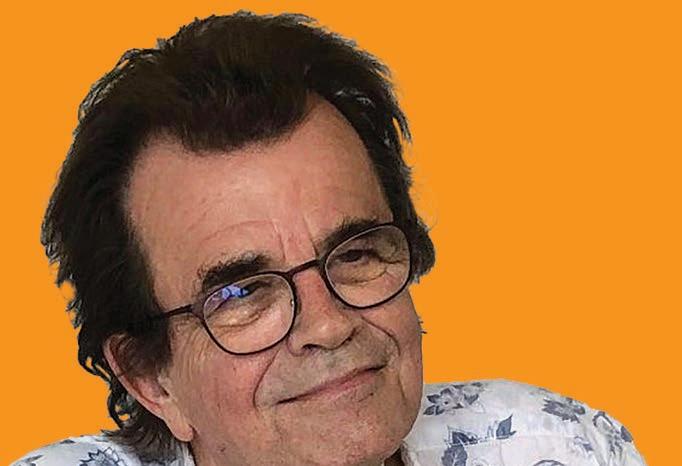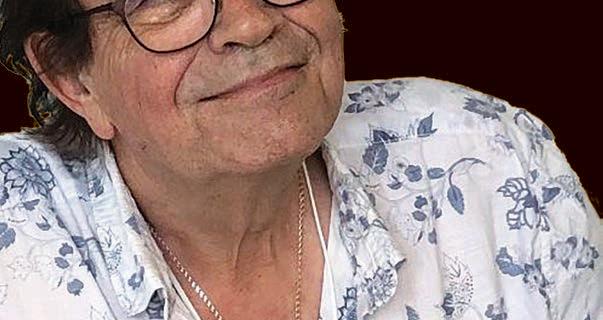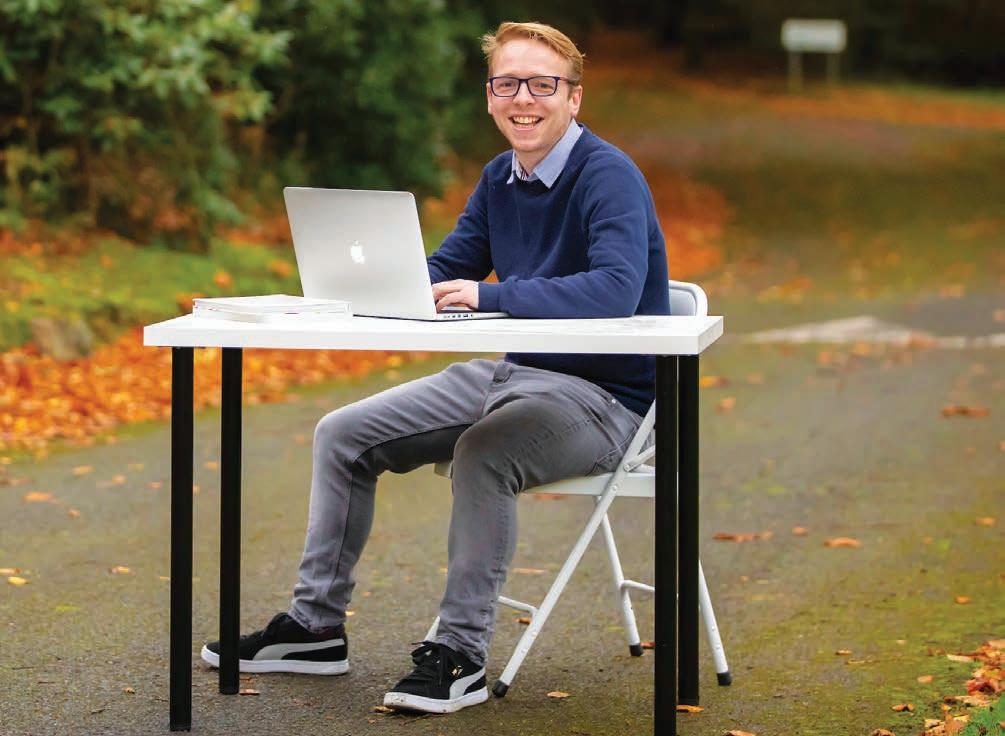
9 minute read
Paul Hopkins
The Fact OfThe Matter

Advertisement

PAUL HOPKINS PAUL HOPKINS
Trillions of viruses, and those boom-time rats
When my younger brother and I were small, before our sister arrived into the world, and we would get one of those many childhood ailments, my mother would send for the doctor, having created a bed downstairs for whoever was laid low, by way of two armchairs facing each other o ering a temporary cocoon. e doctor, O’Dolan by name, would eventually arrive, take a temperature and use his cold stethoscope on us and then say to my mother: “Nothing to worry about here. It’s germs, Mrs Hopkins. Just plenty of ice cream to keep down the temperature. Germs, just germs ...”
And when vaccines were found for those ‘germs’, that were, say, the potentially fatal polio and measles, I remember, a little older by then, running a mile away and hiding down the laneway because I knew Dr O’Dolan was coming to give my brother and me the needle. And I dreaded needles, though I’ve long outgrown such illogical fear.
Get this: ere are more than a staggering quadrillion quadrillion individual viruses existing on Earth, that’s 10 million to the power of 31 — enough to assign one to every star in our universe 100 million times over.
Viruses in ltrate every aspect of our natural world, in seawater, drifting through the atmosphere and lurking there in minuscule motes of soil.
Generally considered nonliving entities, these micro buggers or pathogens can only replicate with the help of a host, and they are capable of hijacking organisms from every branch of the tree of life — including a multitude of human cells.
Yet, most of the time, we humans manage to live in this virus- lled world relatively free of bug-related illness. e reason has less to do with the human body’s resilience to disease than the biological quirks of viruses themselves... in short, the little feckers just don’t nd us interesting enough to be bothered.
Still, as the ongoing Covid19 pandemic clearly demonstrates, outbreaks of new human viruses do happen — and they aren’t as unexpected as they might seem.
To better forecast and prevent outbreaks, scientists are homing in on the traits that may explain why some viruses, and not others, can make the hop into us humans. Some mutate more frequently, perhaps easing their spread into new hosts, while others are helped along by human encounters with animals that provide opportunities for that jump.
Most new infectious illnesses enter the human population the same way the coronavirus has done: as a zoonosis, or a disease that infects people by way of an animal. Mammals and birds alone are thought to host up to 1.7 million undiscovered types of virus. Bacteria, fungi, and parasites can also pass from animals to people, but these pathogens can typically reproduce without infecting human hosts.
To make a successful transition from one species to another, a virus must clear a series of biological hurdles. e pathogen has to exit one animal and come into contact with another, then establish an infection in the second host. is is known as a ‘spillover event’. After the virus has set up shop in a new host, it then needs to spread to other members of that species. And so it goes.
Exact numbers are hard to estimate, but the vast majority of animal-to-human spillovers likely result in dead-end infections that never progress past the rst individual, according to virologists at Stanford University.
Bats and rodents are considered high-risk when it comes to passing on viruses to us humans — a source for diseases that can hop over to little old us, and sometimes lead to epidemics.
Some scientists have even argued that the animals have certain traits that increase the likelihood of moving from animal to people, and that they should be monitored more closely as a result.
However, new analysis suggests that bats and rodents are ‘unexceptional’ in their propensity to host viruses that infect humans.
Looking at the largest databases of viruses and hosts across several species of mammal and bird, researchers from Scotland have found that the number of bat and rodent viruses that have infected people is proportionate to the number of species contained in those groups, according to ecologists at the University of Glasgow.
But not everyone agrees.
As bats harbour several viruses that cause severe disease in people, including rabies, Ebola and severe acute respiratory syndrome-related coronavirus (SARS-CoV) it makes sense that they — along with rodents — are the focus of most viral-detection e orts.



EU travel chiefs’ dire warnings over Covid travel
THE World Travel & Tourism Council (WTTC) and the European Travel Commission (ETC) have warned that the imposition of new travel restrictions this winter would be devastating to EU economies – and still wouldn’t do anything to reduce transmission rates. e WTTC and ETC, supported by a number of key travel stakeholders, have urged EU Member States to align their responses to the deteriorating COVID-19 situation and avoid imposing any limits to the freedom of movement across Europe. e organisations say the sector cannot a ord inconsistent and ever-changing national responses, and a joint EU approach is the only solution to saving the struggling Travel & Tourism sector in Europe.
Restrictions not e ective e European Centre for Disease Prevention and Control (ECDC) is now acknowledging that EU travel restrictions have not had a signi cant impact on reducing virus transmission, hospitalisations or deaths.
WTTC and ETC stress that measures aiming at restricting border crossing would not have any health bene ts but could result in a huge economic impact to the region.
According to latest WTTC research, up to 900,000 jobs are at risk across the EU’s Travel & Tourism sector this year if travel restrictions are reimposed this winter.
Furthermore, governments across the EU could see up to €35 billion wiped from the sector’s contribution to the economy before the end of 2021 if severe travel restrictions come back into force.
Julia Simpson, WTTC President & CEO, said: “We urgently need to restore the con dence to travel and not create more uncertainty.
“ e vaccination rollout across the EU is among the best in the world with 65% of the population now fully vaccinated. We cannot a ord to let all the hard-earned progress made this year to be reversed. is will have catastrophic consequences for jobs and livelihoods.”
See EU movers on travel, Page 14
Vicky: ‘just let me have Christmas with my kids’
CERVICAL smear campaigner Vicky Phelan has said she didn’t believe she’d “see Christmas” only a month ago, following her decision to stop chemotherapy.
Ms Phelan (pictured), who has been a vocal campaigner for hundreds of women who were a ected by the cervical check scandal, said she was receiving end-oflife ‘palliative care’, and told e Late
Late Show that she would rather her children have memories with her over the coming weeks, even if it means a shorter time spent with them.
“If I go sooner, so be it,” the Mooncoin native told host Ryan Tubridy.
“Four weeks ago, I didn’t think I’d see Christmas. at’s how real this is for me at this stage, like I spoke to my oncologist when I made the decision not to have any more chemotherapy, I mean, I think he was hoping I’d have a few more sessions.
“And I just said, no, I’m not doing this to my kids. I’m not doing this to myself at this stage.”
Ms Phelan said she did have a “quality of life” at present, following her decision to stop palliative chemotherapy, and said she had been bolstered in her hopes to spend her remaining time with her children, 16-year-old Amelia and 10-year-old Darragh.
“I would rather my children have memories of doing stu with me and if I go sooner, so be it.”
Ms Phelan explained that she received a message from one woman in particular which has stuck with her.
“She told me she was 10 when her mother died, so the same age as what my son is now. All I have are memories of my mother, are her being thrown in bed, sick and su ering and she said I think what you’re doing is so brave.
“She said I would rather have had a shorter time with my mother but more quality and I just think, you know, those kinds of messages to me really validate what I’m doing.
“For me, it’s the right thing, and I know it’s not for everybody, but for me, I just think no, I would rather my children have memories of doing stu with me and if I go sooner, so be it.”
Phelan was instrumental in exposing the cervical check controversy, after launching a High Court case against a US laboratory over incorrect smear test results from 2011.


How going back to college landed tech man Richard his dream job
A KILKENNY man who has started out in his dream career thanks to an innovative online computing conversion course from Waterford Institute of Technology (WIT) recommends a return to education for any adults keen to change career.
Former St Kieran’s College student Richard Whitney, from Stoneyford, and who has just nished the twoyear programme in 2020, had long held an interest in technology.
“After I nished school, I enrolled in an IT course at WIT. Unfortunately, due to life and family circumstances I was unable to complete the course. I had hoped to resume my education but as the years went by it became harder and harder to return to education.
“I already knew I liked computer science from the time spent on my previous course. I began looking at what options were available to me and discovered that the HDip in Computer Science o ered at WIT suited my needs perfectly,” he said. e two-year part-time course is heavily subsidised through Springboard+.
“ e lectures and learning material are delivered completely online so this allowed me to continue working full time while doing the course. I was particularly drawn to the sixmonth work placement at the end of the course.
Richard Whitney did his six-month work placement with CGM Inc, a software development company in Waterford, and was fortunate to be o ered a permanent position upon completion.
Parties ‘should support Bill’ for peat’s sake
IFA President Tim Cullinan has welcomed the Bill to recommence the harvesting of horticultural peat. e Bill seeks to introduce a single step system for the licensing of horticultural peat harvesting. It will be instrumental in easing the pressure on the horticulture industry.
He acknowledged the e orts of Senator Regina Doherty and Senator Robbie Gallagher in bringing it forward.
IFA Hardy Nursery Chairman Val Farrell said that, as it stood, the future of the horticulture sector was in jeopardy as the industry was left with no alternative but to import peat from the Baltic regions for the domestic market.
“Importing peat will have lasting consequences for the sector. Already, it has resulted in hugely increased costs. is in turn will have a real impact on the competitiveness of Ireland’s sustainable horticulture sector,” he said.
Mr Farrell said that, along with the carbon footprint associated with transport, this Baltic peat can shrink at twice the rate of Irish peat, thus emitting more carbon.











